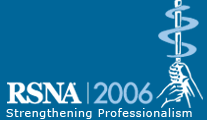
Abstract Archives of the RSNA, 2006
Giuseppe Petralia MD, Presenter: Nothing to Disclose
Lorenzo Preda MD, Abstract Co-Author: Nothing to Disclose
Gabriele D Andrea, Abstract Co-Author: Nothing to Disclose
Gioacchino Giugliano MD, Abstract Co-Author: Nothing to Disclose
Barbara Jereczek-Fossa MD, Abstract Co-Author: Nothing to Disclose
Massimo Bellomi MD, Abstract Co-Author: Nothing to Disclose
To assess potential of CTp for monitoring induction chemotherapy in patients with squamous cell carcinoma (SCCA) of the upper aerodigestive tract. To investigate whether baseline tumor perfusion might predict response to therapy.
From 3/2005 to 3/2006, 14 consecutive patients with locally advanced SCCA of the upper aerodigestive tract (stage III-IV) were enrolled in the study and underwent baseline CTp; At the moment seven patients already underwent follow-up CTp after therapy completion. Thin section (1.2 mm thickness) MDCT of head and neck for tumor volume assessment (sum of all tumor areas, obtained by ROIs manually drawing along visible tumor margins in each slice where tumor was detectable, multiplied by slice thickness) was performed in the same sitting as baseline and follow-up CTp. Perfusion parameters (BF, blood flow; BV, blood volume; MTT, mean transit time; PS, permeability surface) of tumor were calculated by dedicated software (CT perfusion 3, GE, Milwaukee, WI) and statistically correlated with tumor volume, both in baseline and follow-up evaluation.
All 7 followed-up patients had tumor volume reduction (range, 76-100%). BF, BV and PS of tumor were significantly higher in tumor than normal tissue (p<.05); BF and BV decrease following therapy significantly correlated with tumor volume reduction (both, R=.75).Trend to correlation was found between baseline tumor BV and tumor volume reduction (R.62).
CTp showed potential for monitoring the response to induction chemotherapy in patients with SCCA of the upper aerodigestive tract. From our preliminary results, high BV may predict high tumor volume reduction following therapy.
CT perfusion can be an effective tool for induction chemotherapy monitoring in patients with squamous cell carcinoma of upper aerodigestive tract.
Petralia, G,
Preda, L,
D Andrea, G,
Giugliano, G,
Jereczek-Fossa, B,
Bellomi, M,
CT Perfusion (CTp) for Monitoring Induction Chemotherapy in Patients with Squamous Cell Carcinoma of the Upper Aerodigestive Tract. Radiological Society of North America 2006 Scientific Assembly and Annual Meeting, November 26 - December 1, 2006 ,Chicago IL.
http://archive.rsna.org/2006/4435473.html
Accessed August 28, 2025

